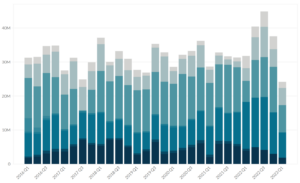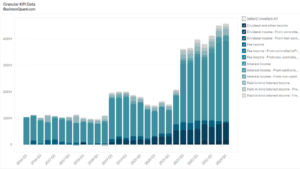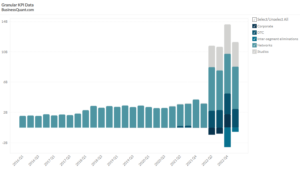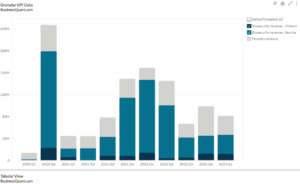
United Parcel Service (UPS) Revenue Breakdown (2013-2022)
Exclusive Data
You need the Pro Plan to access KPI data
- Full access to the platform
- KPI data & segment financials on US stocks
- Financial data on thousands of stocks
- Download data in xlsx and csv formats
Pro Plan
$49 per month*
60% discount ends in:
.
About
More information
Subscribe to Pro or Enterprise plans to unlock this feature.
Contact the Analyst
Subscribe to Pro or Enterprise plans to unlock this feature.
Become a smarter investor today.
Access KPIs & Segment Financials on US stocks
This statistic highlights United Parcel Service (UPS) Revenue Breakdown, split between US and International regions, reported annually from 2013 onwards.
United Parcel Service (UPS) Revenue Breakdown
| Region | 2021 | 2022 | Contribution in 2022 |
| International | 22,911,000,000 | 32,002,000,000 | 29.06% |
| US | 74,376,000,000 | 78,110,000,000 | 70.94% |
| Total | 97,287,000,000 | 110,112,000,000 | 100.00% |
United Parcel Service (UPS) has witnessed significant revenue growth from 2013 to 2022, reaching a total revenue of $110.1 billion in 2022 from $55.4 billion in 2013. This growth can be attributed to the company’s expanding operations both domestically and internationally.
US Revenue Contribution
The US segment has been the primary revenue driver for UPS over the years, contributing 70.94% ($78.11 billion) of the total revenue in 2022. This indicates a steady increase from $74.4 billion in 2021. The growth in the US market can be attributed to several factors.
First, an upsurge in e-commerce and online shopping has boosted package deliveries, especially during the pandemic when more consumers turned to online shopping. Second, UPS’s well-established infrastructure and efficient logistics network in the US allowed the company to capitalize on the growing demand for fast and reliable deliveries. Lastly, strategic investments in technology and last-mile delivery solutions have further strengthened its position in the domestic market.
International Revenue Contribution
The international segment has shown remarkable growth, contributing 29.06% ($32.0 billion) of the total revenue in 2022, a notable increase from $22.9 billion in 2021.
This growth in the international market can be attributed to UPS’s efforts to expand its global footprint and tap into emerging markets. The increasing globalization of businesses has driven cross-border shipments, and UPS’s expertise in handling international logistics has helped it gain a competitive edge. Additionally, the rise in e-commerce on a global scale has led to higher demand for international shipping services, further boosting UPS’s international revenue.
Overall, UPS’s revenue breakdown showcases a balanced contribution from the US and international markets. The company’s strategic focus on e-commerce, technology, and global expansion has enabled it to capitalize on market trends and maintain steady revenue growth. Looking ahead, UPS is likely to continue its efforts to innovate and optimize its operations to cater to the evolving needs of customers, both in the US and around the world. However, potential challenges in global trade dynamics and competition in the logistics industry may require UPS to stay adaptive to sustain its growth trajectory.
Company Overview
United Parcel Service (UPS) was incorporated on August 28, 1907, and is headquartered in Atlanta, Georgia, USA. The company’s primary goal is to provide comprehensive package delivery and supply chain management solutions to customers worldwide. UPS operates a vast global network of delivery vehicles, aircraft, and distribution centers to facilitate timely and reliable deliveries.
UPS serves a diverse range of customers, including individuals, small and medium-sized businesses, and large corporations across various industries. Its services encompass domestic and international shipping, freight forwarding, e-commerce logistics, and specialized industry solutions.
Risks for UPS include intense competition in the logistics sector, fluctuating fuel prices impacting operational costs, and potential disruptions in global trade affecting international shipping volumes.
For the future, UPS aims to continue leveraging technology and automation to optimize its operations, expand its international presence in emerging markets, and enhance sustainability initiatives to reduce its environmental impact.
Did you like United Parcel Service (UPS) Revenue Breakdown statistic?
Access more such KPI data points and segment financials on thousands of US stocks, with Business Quant.
You can get started here.
More data on US Stocks

Our Plans
Always know what you’ll pay. No hidden costs or surprises.
- Annual
- Monthly
60% discount till this Sunday
Pro
For serious investing
-
Company KPI data Access segment financials, non-GAAP metrics and KPI data from presentations and filings. Examples include financials by segment / region / product category, AT&T's broadband subscriber trends, Tesla's deliveries by model and lots more.
-
Stock research tools Features include : stock screener, stock comparison, industry financials, stock warnings, advanced charting tools, timeseries tables, scatter charts, financial statements, stock reports, SEC filings, stock ratings, institutional and insider ownership data. There are 200+ financial items and ratios on thousands of US stocks.
-
Industry data & tools Access premium operating data on 40+ industries. Examples include market share, smartphone shipments by vendor, subscribers by wireless carrier, historical gold production. There are 20,000+ such statistics.
Enterprise
For tailored workflows
-
All of Pro plan Get unfettered access to all our dashboards and dossiers.
-
Custom built features Get tailored dashboards built specially for you , based on your set of requirements, to simplify your research workflow.
-
Admin billing Back-end documentation support and multi-seat licensing.
* Billed annually, local taxes extra.
60% discount on Annual plan
Pro
For serious investing
-
Company KPI data Access segment financials, non-GAAP metrics and KPI data from presentations and filings. Examples include financials by segment / region / product category, AT&T's broadband subscriber trends, Tesla's deliveries by model and lots more.
-
Stock research tools Features include : stock screener, stock comparison, industry financials, stock warnings, advanced charting tools, timeseries tables, scatter charts, financial statements, stock reports, SEC filings, stock ratings, institutional and insider ownership data. There are 200+ financial items and ratios on thousands of US stocks.
-
Industry data & tools Access premium operating data on 40+ industries. Examples include market share, smartphone shipments by vendor, subscribers by wireless carrier, historical gold production. There are 20,000+ such statistics.
Enterprise
For tailored workflows
-
All of Pro plan Get unfettered access to all our features.
-
Custom built features Get tailored dashboards built specially for you , based on your set of requirements, to simplify your research workflow.
-
Admin billing Back-end documentation support and multi-seat licensing.
* Local taxes extra.






